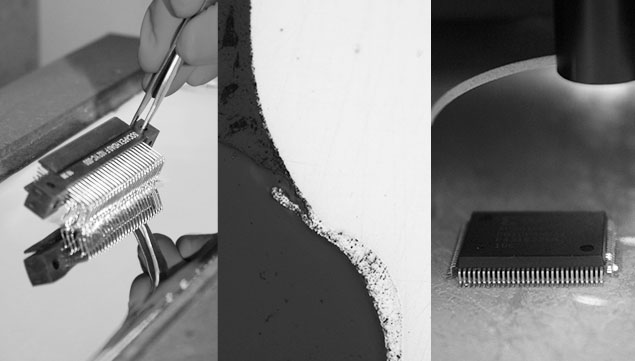The RoHS directive upset the world of electronics by banning the use of lead, which was part of many alloys. Previously, components were only re-tinned in rare cases, for example, to remove gold from component legs to make the soldering more reliable. One of the main virtues of lead is the much lower re-soldering temperature of electronic boards than that of pure tin (around 215°C instead of 240°C) and the absence of whiskers, a monocrystalline structure that develops on pure tin soldering over time which can lead to short-circuits.
What is re-tinning?
Re-tinning is a surface treatment operation. A layer of tin is applied to a metal part.
The component leads are successively immersed in two baths of pure tin; the first for cleaning, the second for tinning. For the forward process, re-tinning is of interest because it reduces the quantity of lead in the component.
The effect of this process is to dilute the lead (which does not completely disappear) to bring its proportion to less than 1% in the finish, which, given the component weight, will result in an overall lead content of less than 0.1%.
The backward process involves adding lead to the component finish to prevent the development of whiskers. The passage of the component terminals in the two baths will allow for the addition of lead representing a final content of between 20 and 35%. For this addition to be effective against whiskers, make sure that it covers the entire component leg, without leaving any areas of pure tin, and also ensure during the operation that the melted alloy’s proximity to the component’s body, does not create any stress, which may in turn jeopardise the component’s reliability.

Re-tinning checks
All processes are subject to checks. Before a re-tinning series, we perform the operation on a product sample in order to make sure that the component is not subject to stress and to verify that the re-tinning can will work well. We check:
- That there hasn’t been any delamination or that the delamanation is acceptable for plastic components (using acoustic microscopy)
- The intermetallics created by the operation (by cross-section and inspection using an optical and/or electronic microscope)
- The finishing lead content (using X-ray fluoroscence).
- The component solderability (wetting balance)
In the series phase, the components are visually inspected under a a binocular microscope to check that there are no bridges between the legs, no solder balls and no flux residue. The tinning baths are subject to regular checks of their pollutant content and temperature.
Retinning benefits
Re-tinning allows a protective layer to be placed on the part and thus provides protection from corrosion, offering better electrical conductivity, and also improving the part’s weldability.
Eliminating the risk of whiskers
Whiskers are crystalline tin structures that develop on some finishes of pure tin components’ legs. Replacing that finish with a tin-lead alloy increases product reliability.
Gold embrittlement of solder joints
Depending on the proportion used, the dissolution of the gold finish used in the alloy on the component can weaken the solder. Pre-tinning of gold plated components eliminates that risk.
Component re-tinning
Re-tinning involves re-tinning the component with the same alloy as the original, and removing any traces of oxidation that has taken place due to prolonged storage. Re-tinning may or may not be preceded by stripping depending on the extent of oxidation.
Alloy conversion
SnPb re-tinning: allows the use of lead-free components with leaded processes
Sn re-tinning: allows the use of old components with new processes after checking the compatibility of the resin with the RoHS process
Tame-Component offers re-tinning operations that meet RoHS requirements
Resources
- Re-tinning with dip
- Selective wave re-tinning
- X-ray fluorescence and/or micro-section finish control






